 |
| Positioning gambonya memang tak centre... tapi orangnya centre... |
Sebelum2 ni ada awok naik kan entri Wordless Wednesday, Wordless Wednesday, Wordless Wednesday, sebelum ni...
dan kebetulan hari ni di akhbar Kosmo ada keluo artikel berkaitan dengan Pusat Konservasi Hidupan Liar, Sungkai di mukasurat 19....
Pusat Konservasi Hidupan Liar, Sungkai ni...
tak ramai yang tau.....
malahan awok sendiri baru je tau tempat ni....
sebabnya.....
awok pasti ramai yang ke Sungkai....
akan ke Taman Rekreasi Air Panas, Felda Sg Klah tu je....
pergi bermandi-manda.....
apa yang menariknya disini....
tak semua fauna ditempatkan disini.....
antara yang ada disini adalah Seladang, Rusa, Burung Merak Pongsu, Burung Kuang Raya dan Burung Kuang Cermin .....
Pusat Konservasi Hidupan Liar, Sungkai diuruskan oleh Jabatan Perhilitan Perak....
dengan keluasan melebihi dari 50 hektar....
Pusat ini telah mula beroperasi pada tahun 1971.....
dengan tujuan penubuhan adalah untuk mengawal dan mengelakkan dari kepupusan haiwan yang terancam ......
selain dari itu pusat ini juga merupakan pusat pembiakan haiwan terancam.....
pada yang berminat nak ke Pusat Konservasi Hidupan Liar , Sungkai ni.....
Kome boleh hubungi nombor dan alamat yang tertera dibawah:-
Pusat Pemuliharaan Hidupan Liar
Jabatan Perhilitan Sungkai
35600 Sungkai
Perak.
Tel: +605 438 9482
Ke sana menggunakan kereta:
Sila gunakan lebuhraya PLUS dan kome keluo di exit tol Sungkai. Sila susur ke sebelah kanan yang akan menuju ke Pekan Sungkai. Pusat Pemuliharaan Hidupan Liar ni terletak 15km dari Pekan Sungkai. SILA PASTIKAN kome tak terlepas papantanda Menderang disebelah kiri dan Stesyen Minyak Shell di sebelah kanan. Susur ke kanan sebelum Stesyen Minyak Shell dan teruskan perjalanan kome. Yang pasti kereta kome akan berhabuk disebabkan jalan masuknya yang berdebu dan semakin sempit sehinggalah kome berjumla dengan papantanda Pusat Pemuliharaan Hidupan Liar.
Antara Fauna yang terdapat disini (Salin Tampal dari Internet)
Malayan Sambar Deer (Cervus unicolor equinus)The spacious wildlife oasis with lush green surroundings and huge shady trees is just perfect for the Sambar deers, seen roaming unrestrained and appeared so at home, as if in their own natural habitat. The Malayan subspecies of sambar is the smallest in body and antler size as compared with the Indian Sambar Deer or the Sri Lankan ones that are rated as the largest in the genus ‘Cervus’.
What a pity that we missed out on the Timor Deers and Mousedeers, being unaware then of their existence at the wildlife reserve.Some information on the Malayan Sambar Deer:
- Scientific name: Cervus unicolor equinus (syn. Rusa unicolor equinus)
- Common name: Malayan Sambar Deer, Rusa Sambar in Malay
- Kingdom: Animalia
- Phylum: Chordata
- Class: Mammalia
- Order: Artiodactyla
- Family: Cervidae
- Genus: Cervus (syn: Rusa)
- Species: C. unicolor (syn: R. unicolor)
- Colour: Dark brown background with black tail
- Body length: 94-143 cm (male), 74-210 cm (female)
- Height: 94-143 cm (male), 100-180 cm (female)
- Weight: 74-200 kg
- Male antlers: 29-56 cm in length
- Distribution: In the Asian continent of China, Sri Lanka, India, Sumatra, Philippines and Peninsula Malaysia
- Breeding: Sambars usually mate between September to January. Gestation period is about 240-270 days with one calf per birth
- Weaning: 8-9 months
- Life span: 12-13 years
Malayan Gaur (Bos Gaurus hubbacki)This extensive wildlife reserve is also a sanctuary for the endangered Malayan Gaur, the largest species of cattle, bigger than the Cape Buffalo, water buffalo and bison. Malayan Gaur or Seladang in Malay, is the smallest among the 3 subspecies of gaur that includes the Southeast Asian Gaur (Bos gaurus laosiensis) and the Indian Bison (Bos gaurus gaurus).
- More info: @ Wikipedia
We were advised by one of the staff not to get too close as these huge and gigantic animals can be easily agitated with unfamiliar scent and faces. They looked threatening, no doubt about that. But, being properly contained within iron fences, we were a little brave to move close enough to marvel and enjoy them! Looking like water buffalo in front and like the domestic cattle at the back, they appear menacingly powerful with a highly muscular body and a pair of horns at both sides of the head. Both sexes have these horns that curve upwards and bend inward and slightly backward at the tips. The bulls are substantially larger in size than the cows.Some information on the Malayan Gaur:
- Scientific name: Bos gaurus hubbacki
- Common name: Malayan Gaur, Seladang in Malay
- Kingdom: Animalia
- Phylum: Chordata
- Class: Mammalia
- Order: Artiodactyla
- Family: Bovidae
- Genus: Bos
- Species: B. gaurus
- Colour: body – glossy black (male), dark brown (female); knee downwards whitish to dirty yellow
- Body length: 250-330 cm
- Shoulder Height: 170-220 cm
- Weight: 1000-1300 kg
- Distribution: Thailand and Malaysia
- Breeding: Year-round, but typically peaks between December and June. Gestation period is about 275 days with one calf per birth, rarely two
- Weaning: 7-12 months
- Sexual maturity: in the 2nd or 3rd year
- Life span: about 30 years
Pheasants and HornbillsThis area was quite a disappointment as the huge cages that housed these beauties are covered with tightly spaced wire-netting materials that not only hinder proper viewing but photography too. Rather frustrating as we were unable to enjoy the full beauty of these birds and have clear shots of them.
- More info: @ Wikipedia
Pheasant species seen there include the following:
- Great Argus (Argusianus argus; Kuang Raya in Malay)
- Malaysian Peacock (Polyplectron malacense; Merak Pongsu)
- Mountain Peacock (Polyplectron inopinatium; Kuang Cermin)
- Crestless Fireback (Lophura erythrophthalma; Merah Mata)
- Crested Fireback (Lophura ignita; Pegar)
The Great Argus (Argusianus argus), was such a delight to watch. Frequently opening its beautiful and fabulously patterned wings to show off, as if displaying specially for us. Simply lovely!
- Green Peafowl (Pavo muticus; Merak Hijau)
This pheasant is large, measuring up to 2 m in length, with long tail feathers and secondary wing feathers that are distinctly decorated with large eye-spots. Plumage generally rusty brown with intricate pattern and spots of chestnut, brown, white, black and grey. It has a small head with blue bare skin on its head and neck, short black crest, rufous red upper breast and red legs.Some information on the Great Argus:
- Scientific name: Argusianus argus
- Common name: Great Argus, Argus Pheasant, Kuang Raya in Malay
- Kingdom: Animalia
- Phylum: Chordata
- Class: Aves
- Order: Galliformes
- Family: Phasianidae
- Genus: Argusianus
- Species: A. argus
- Distribution: Borneo, Sumatra and Peninsula Malaysia
- Habitat: Jungle and forests, from sea-level to 4,000 feet
Hornbill species residing there include these below:
- More info: @ Wikipedia
- Oriental Pied Hornbill (Anthracoceros albirostris convexus; Enggang Lilin)
- Black Hornbill (Anthracoceros malayanus; Enggang Hitam)
- White Crown Hornbill (Berenicornis comatus; Enggang Jambul Putih)
- Rhinoceros Hornbill (Buceros rhinoceros; Enggang Badak)
Sorry, no hornbill pictures to share here except the one below but you can enjoy them at Hornbills Photo Gallery by Wong Tsu Shi.
- Great Hornbill (Buceros bicornis; Enggang Papan)
An Oriental Pied Hornbill suddenly flew overhead and landed on a tree branch within our view unannounced. How very fortunate! I was extremely thrilled and happy…gotcha on candid camera!
Some information on the Oriental Pied Hornbill:
- Scientific name: Anthracoceros albirostris convexus
- Common name: Oriental Pied Hornbill, Malaysian Pied Hornbill, Enggang Lilin in Malay
- Kingdom: Animalia
- Phylum: Chordata
- Class: Aves
- Order: Coraciiformes
- Family: Bucerotidae
- Genus: Anthracoceros
- Species: A. albirostris
- Distribution: Bangladesh, Bhutan, Brunei, Cambodia, China, India, Indonesia, Laos, Malaysia, Myanmar, Nepal, Singapore, Thailand and Vietnam.
- Habitat: Tropical and subtropical moist lowland forests.
- More info: @ Wikipedia and Forest Department, Sarawak


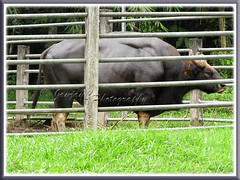
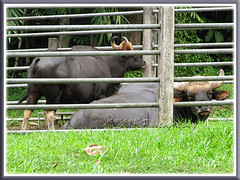
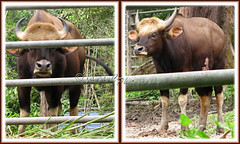
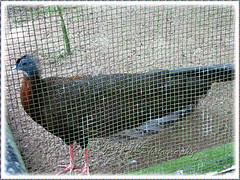
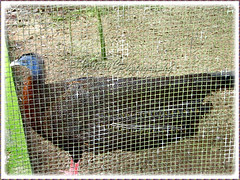
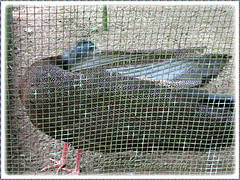






Yop, tringin nak bwk twin gi tgk binatang, tapi takde kesempatan, papanye asyik outstation ja..huhuu....
ReplyDeletetapi mmg kite tak tau pun ade pusat hidupan liar kat Sungkai, yg tau kat Zoo negara ja, hahahaha.. tengs da info Yop...
bestnya...
ReplyDeleteMoh kita
ReplyDelete